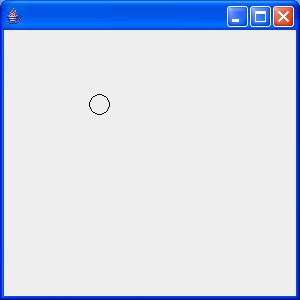Write your Beans this way so they can run in a multithreaded environment

// : c14:BangBean2.java
// You should write your Beans this way so they
// can run in a multithreaded environment.
// From 'Thinking in Java, 3rd ed.' (c) Bruce Eckel 2002
// www.BruceEckel.com. See copyright notice in CopyRight.txt.
import java.awt.Color;
import java.awt.Font;
import java.awt.Graphics;
import java.awt.event.ActionEvent;
import java.awt.event.ActionListener;
import java.awt.event.MouseAdapter;
import java.awt.event.MouseEvent;
import java.awt.event.MouseMotionAdapter;
import java.io.Serializable;
import java.util.ArrayList;
import javax.swing.JFrame;
import javax.swing.JPanel;
public class BangBean2 extends JPanel implements Serializable {
private int xm, ym;
private int cSize = 20; // Circle size
private String text = "Bang!";
private int fontSize = 48;
private Color tColor = Color.RED;
private ArrayList actionListeners = new ArrayList();
public BangBean2() {
addMouseListener(new ML());
addMouseMotionListener(new MM());
}
public synchronized int getCircleSize() {
return cSize;
}
public synchronized void setCircleSize(int newSize) {
cSize = newSize;
}
public synchronized String getBangText() {
return text;
}
public synchronized void setBangText(String newText) {
text = newText;
}
public synchronized int getFontSize() {
return fontSize;
}
public synchronized void setFontSize(int newSize) {
fontSize = newSize;
}
public synchronized Color getTextColor() {
return tColor;
}
public synchronized void setTextColor(Color newColor) {
tColor = newColor;
}
public void paintComponent(Graphics g) {
super.paintComponent(g);
g.setColor(Color.BLACK);
g.drawOval(xm - cSize / 2, ym - cSize / 2, cSize, cSize);
}
// This is a multicast listener, which is more typically
// used than the unicast approach taken in BangBean.java:
public synchronized void addActionListener(ActionListener l) {
actionListeners.add(l);
}
public synchronized void removeActionListener(ActionListener l) {
actionListeners.remove(l);
}
// Notice this isn't synchronized:
public void notifyListeners() {
ActionEvent a = new ActionEvent(BangBean2.this,
ActionEvent.ACTION_PERFORMED, null);
ArrayList lv = null;
// Make a shallow copy of the List in case
// someone adds a listener while we're
// calling listeners:
synchronized (this) {
lv = (ArrayList) actionListeners.clone();
}
// Call all the listener methods:
for (int i = 0; i < lv.size(); i++)
((ActionListener) lv.get(i)).actionPerformed(a);
}
class ML extends MouseAdapter {
public void mousePressed(MouseEvent e) {
Graphics g = getGraphics();
g.setColor(tColor);
g.setFont(new Font("TimesRoman", Font.BOLD, fontSize));
int width = g.getFontMetrics().stringWidth(text);
g.drawString(text, (getSize().width - width) / 2,
getSize().height / 2);
g.dispose();
notifyListeners();
}
}
class MM extends MouseMotionAdapter {
public void mouseMoved(MouseEvent e) {
xm = e.getX();
ym = e.getY();
repaint();
}
}
public static void main(String[] args) {
BangBean2 bb = new BangBean2();
bb.addActionListener(new ActionListener() {
public void actionPerformed(ActionEvent e) {
System.out.println("ActionEvent" + e);
}
});
bb.addActionListener(new ActionListener() {
public void actionPerformed(ActionEvent e) {
System.out.println("BangBean2 action");
}
});
bb.addActionListener(new ActionListener() {
public void actionPerformed(ActionEvent e) {
System.out.println("More action");
}
});
run(bb, 300, 300);
}
public static void run(JPanel panel, int width, int height) {
JFrame frame = new JFrame();
frame.setDefaultCloseOperation(JFrame.EXIT_ON_CLOSE);
frame.getContentPane().add(panel);
frame.setSize(width, height);
frame.setVisible(true);
}
} ///:~
Related examples in the same category